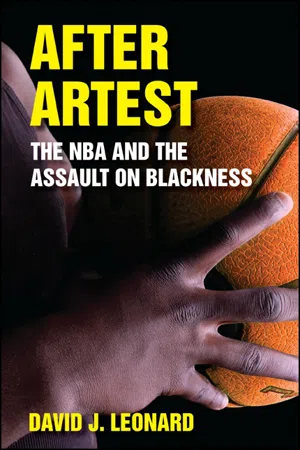
- 286 pages
- English
- ePUB (mobile friendly)
- Available on iOS & Android
About This Book
On November 19, 2004, a fight between NBA players Ron Artest and Ben Wallace escalated into a melee involving several other players and many fans. The "Palace Brawl, " writes David J. Leonard, was a seminal event, one that dramatically altered outside perceptions of the sport. With commentators decrying the hip hop or gangsta culture of players, the blackness of the NBA was both highlighted and disdained. This was a harsh blow to the league's narrative of colorblindness long cultivated by Commissioner David Stern and powerfully embodied in the beloved figure of Michael Jordan. As Leonard demonstrates, the league viewed this moment as a threat needing intervention, quickly adopting policies to govern black players and prevent them from embracing styles and personas associated with blackness. This fascinating book discloses connections between the NBA's discourse and the broader discourse of antiblack racism. Particular policy changes that seemed aimed at black players, such as the NBA dress code and the debate over a minimum age requirement, are explored.
Frequently asked questions
Information
The real question, how does it feel to be a problem.—W.E.B. DuBois, 1903 (Quoted in Jackson 2006, p. 9)
Ron Artest more than likely will be suspended, but so should Kobe.(Resnick 2009)
Kobe vs. Artest: Proof Artest Will Kill Your Team(2009)
NBA Bad Boy Ron Artest of L.A. Lakers Admits He Had A Problem: Drinking During Games!(Douglas 2009)
Trevor Ariza loses shoe, Ron Artest tosses it into the stands.(2009)
INTRODUCTION
- To examine the changing racial landscape of the NBA following the November 22, 2004, Palace Brawl, which involved Ron Artest, several Detroit Piston fans, and several other Pacer (and Pistons) players.
- To think about how race (particularly anti-black racism), ideas of colorblindness, and white racial frames colored the conversations and resulting policy shifts within the NBA.
- To reflect on the broader significance and meaning of a post–Palace Brawl NBA that at one level mirrors hegemonic notions of/about blackness, and yet at another level functions as a privileged (or exceptional) space for the criminalization (and consumption) of black bodies in the perpetuation and denial of dominant white racial frames.
GUIDING FRAMEWORKS
New Racism2
Yet this new ideology has become a formidable political tool for the maintenance of the racial order. Much as Jim Crow racism served as the glue for defending a brutal and overt system of racial oppression in the pre–Civil Rights era, color-blind racism serves today as the ideological armor for a covert and institutionalized system in the post–Civil Rights era. And the beauty of this new ideology is that it aids the maintenance of white privilege without fanfare, without naming who it subjects and those who it rewards. (2003, p. 3)
Unlike the old racism, which defined racial difference in terms of fixed biological categories organized hierarchically, the new racism operates in various guises proclaiming among other things race neutrality, asserting culture as a market of racial difference, or making race as a private matter. Unlike the crude racism with its biological referents and pseudoscientific legitimizations, buttressing its appeal to white racial superiority, the new racism cynically recodes itself within the vocabulary of the civil rights movement. (2003, p. 192)
It is a form of racism that utilizes themes related to culture and nation as a replacement for the now discredited biological referents of the old racism. It is concerned less with notions of racial superiority in the narrow sense than with the alleged “threat” people of color pose—either because of their mere presence or because of their demand for “special privileges”—to economic, socio-political, and cultural vitality of the dominant (White) society. It is, in short, a new form of racism that operates with the category of “race.” It is a new form of exclusionary politics that operates indirectly and in stealth via the rhetorical inclusion of people of color and the sanitized nature of its racist appeal. (1997, pp. 20–21)
White Racial Frame
Table of contents
- Title Page
- Copyright Page
- Dedication
- Acknowledgments
- 1. After Artest: The NBA and the Assault on Blackness
- 2. ‘I Went to a Basketball Game and a Vibe Awards Broke Out’ or ‘Negroes Gone Wild’: The Palace Melee and the Racialized Culture War What Else?
- 3. A Crisis Inside and Outside America's Arena: Age Restrictions and the Real Color of Money
- 4. ‘No Bling Allowed‘: The NBA's Dress Code and the Politics of New Racism
- 5. The Palace Brawl and the Colorblind Fantasy
- Notes
- Works Cited: Popular Discourse
- Works Cited: Scholarly Discourse
- List Of Titles in the Suny Series On Sport, Culture, and Social Relations